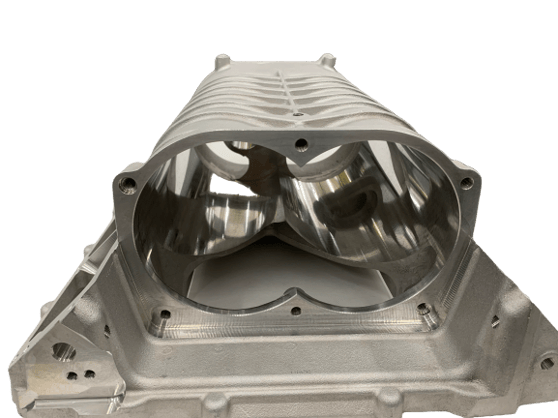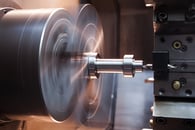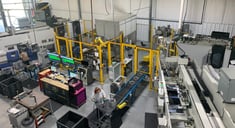Imagine this: a manufacturing technique that’s lasted for more than 6,000 years AND is still highly valued today. That’s metal casting.
More metals have been cast over time: gold around 4,000 BCE, followed by bronze and copper, and then iron around 1,000 BCE. The importance of metal casting cannot be overstated. Even the progress of civilization itself was named after the metal casting processes most used during that span: the Copper Age, the Bronze Age, the Iron Age.
Of course, technical advances have been made throughout the millennia, but the basic principle and benefits remain the same.
Why casting?
Casting simplifies the process of forming metal into products. Here’s how it’s done: Molten metal is poured into a mold to create a desired pattern. To remove the pattern or part, a slight taper, often called a draft, is used on the pattern surfaces. If needed, passages, or cavities, within the casting are made by inserting cores into the casting box once the pattern is removed.
The importance of casting in the manufacturing process is significant. A casting results in fewer components and fewer parts needing to be put together. A weldment that was once a dozen pieces can be cast into one part, resulting in less assembly time, simpler inventory control, and a drop in overall price. Plus, the overall versatility of casting is incredible.
Aluminum die casting advantages
Although recent years are not called “the Aluminum Age,” they could be. Today, aluminum is desired for its light weight and strength. While early commercial aluminum products were castings of cookware and various decorative items, modern applications of die cast aluminum include thin-walled enclosures that require less machining and feature an attractive, very smooth finish surface.
Not only does aluminum create an affordable piece price, it allows for quick cycle times and high-volume production, up to 1,000 pieces a day, depending on machining needs.
As we dive into the three most important methods of casting — sand casting, die casting, and permanent mold casting — remember that the benefits of all three processes are magnified when aluminum is used. The exception is iron, which can’t be put under high pressure, so sand casting is iron’s only casting option.
Sand casting and die casting
Sand mold casting is the most versatile casting method for producing many products, especially aluminum. A pattern is pressed into a fine sand mixture. This forms the mold into which the metal is poured. For die casting, molten metal is pressure forced into a steel die (or mold). Die casting is perfect for precisely formed parts requiring less machining and finishing.
So, how do they compare?
-
Alloy availability: Different alloys are available for use in sand casting (319 or 356 alloy, for instance) that are not possible with die casting. All alloys have different strengths and characteristics based on the product
-
Geometry: Some cores for passages are not possible with die casting, during which the pattern must pull straight out of the mold
-
Speed: Many more die castings can be made in an hour than sand casting, so die casting is normally used for high-volume production
-
Tolerances: Because die casting is a mechanical, steel tool, it can hold tighter tolerances than sand casting (more on tolerances below)
-
Machining: Die casting’s machining costs are less because of having less stock, and certain surfaces are able to stay as cast without any machining required
-
Tooling: Die casting results in a significant increase in the cost of steel tooling. However, the right investment in tooling upfront results in a lower overall piece price
-
Cost: Sand casting is a more expensive piece price process than die casting, yet sand casting can be more economical for small quantities and prototypes, intricate designs, and when the casting itself is very large
Now, let’s address the permanent/semi-permanent mold method, which falls between the previous two in many ways.
Permanent mold or semi-permanent mold
Permanent mold casting involves steel tooling along with sand cores as needed. That tooling investment is more expensive than sand casting tooling but not as expensive as die casting tooling.
As opposed to die casting (high-pressure metal is blown into the mold), the permanent mold process involves either gravity flow or low-pressure flow into the mold. A vacuum may be applied to keep the flow moving smoothly as well as assist in reducing porosity.
Compared to die or sand castings, permanent mold castings can often be stronger. Semi-permanent mold casting means that there are sand cores placed in the mold to create internal passageways that will be removed by burn/shake out. This is used most often with aluminum.
Two common casting defects: porosity and non-cleanup
Liquid naturally travels through pores, or open spaces. A poorly designed part, with too much stock, for instance, opens up porosity. Gas entrapment within a high-pressure mold can create pockets or pits, which could cause a leak.
In sand casting the main cause of porosity is trapped air and/or gas, or possibly a sand defect, such as dirt. Although the process of die casting — using a high-pressure blast of aluminum — creates trapped air more frequently, it typically occurs under the surface of the part. A clean skin, only 2 mm is required, eliminates any porosity issues.
Typically, insufficient stock is caused by either a bent casting or a poorly designed casting (not enough stock built in upfront). In sand casting or permanent mold castings the cause could be excessive grinding or sawing into the surface, or it could be a core shift that causes dimensional issues. Die casting causes could involve trimming or, in most cases, a bent casting (due to thin walls and how it’s ejected from the mold).
Insufficient stock directly leads to non-cleanup. When there’s not enough material, or stock, to cut, the programmed tool doesn’t engage the material; it simply “cuts” air. So, instead of a smooth, machine-cut surface, it’s a cast surface. Non-cleanup may be adjusted in the machine by pushing a cut deeper. However, maintaining a minimum thickness could prevent this technique’s use.
Casting tolerances — overview and importance
Different materials and processes involve different standards. So, depending on the particular process, tolerances are reviewed for positions, length (per inch), and material grades as well as the customer’s own requirements and specs. Plus, associations have their own guiding standards. For example, an aluminum die casting should follow Aluminum Association standards and the North American Die Casting Association (NADCA). However, iron parts should be referenced to ISO 8062.
When tolerances aren’t achieved, a lot can happen …
- More foundry scrap or machine scrap
- Warranty issues from a customer
- A product not functioning properly
- Rework the tooling (cast and/or machine)
- Extra machining
… and none of those are pleasant because, in the end, they all directly affect costs, which could be significant. So, while there are multiple processes and details to consider, the most important thing is to partner with a team that understands this complexity and can explain each process clearly so the right decision is made.
See Stecker’s advantage in casting, machining, tolerances … and more!
Stecker takes on complex manufacturing challenges that others in the industry shy away from. By partnering with an experienced, dedicated, and trusted CNC machine shop, you gain certain advantages.
NOT pigeon-holed into one foundry
When a machine shop owns a foundry the processes and materials are often predetermined regardless if they’re correct or not. On the other hand, having access to a wide supply base with various processes and materials can pair a part with the exact right process and partner. Instead of making the part fit the established process, the part is put into the right process. Stecker has partnerships with over 40 foundries, so Advantage Stecker!
Managing the supplier
From a process standpoint, Stecker adds value by paying attention to how a foundry does business. Process control ensures parts that meet customer requirements. Stecker conducts audits that ensure proper process controls and proper documentation, so Advantage Stecker!
Collaboration
It cannot be overstated: the upfront teamwork between the end user, the CNC machine shop, and the foundry is vital. Once a process is determined, that’s the time to design the part for manufacturability. Stecker has an advantage with different processes and materials, so Advantage Stecker!
A guide with your bottom line in mind
Imagine this scenario: An engineer has a project 75% designed, so it’s sent out to quote. Stecker gets the quote, collaborates with the right foundry, and recommends:
- a switch of the material
- a change in the geometry
- a change in the casting method
- added machining
Upon review, it’s discovered that with the volume projected, a die casting (even with additional upfront tooling costs) may be the best solution. In six months a payoff can be realized, with the project coming in at half the price, so Advantage Stecker!
True teamwork
Stecker solves each individual customer’s unique needs. We’ll explore what you need, review what we can offer, conduct a print review, determine a casting process, discuss what foundry may be a good fit, and uncover the best way to move ahead. It’s a partnership of choosing the best foundry and the best process, so Advantage Stecker (and YOU!)
Now that you know the importance of metal casting and the power of Stecker, read these mini-case studies that show our willingness to dive into challenging CNC machining situations: In a Bind? 4 Projects During Which Stecker Machine Rescued Customers in Need.







